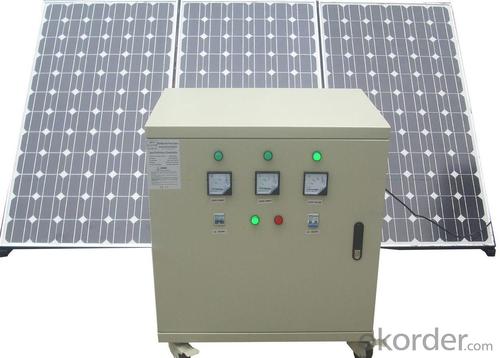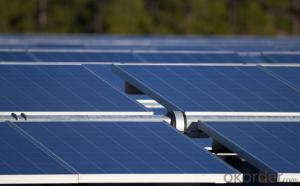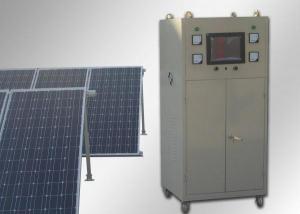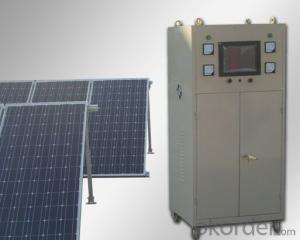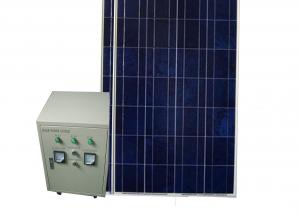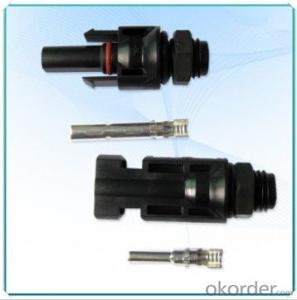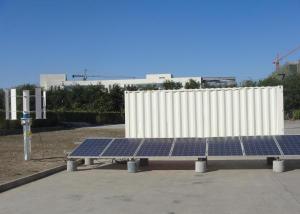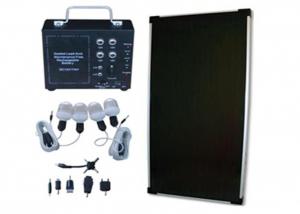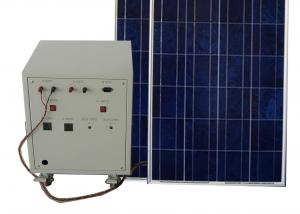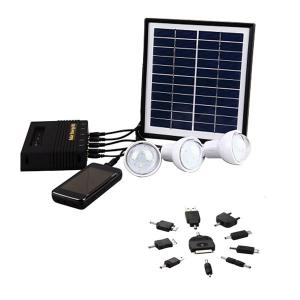Commercial Solar Energy Systems - CNBM Solar Home System CNBM-K5 (500W)
- Loading Port:
- China Main Port
- Payment Terms:
- TT
- Min Order Qty:
- 1 set set
- Supply Capability:
- 1000 sets per month set/month
OKorder Service Pledge
OKorder Financial Service
You Might Also Like
Brief Introduction of Solar Energy System CNBM-K5 (500W)
CNBM Home System-K5 (500W) has a wonderful capacity.It can be used in factory,home,school and other CNBM Home System-K5 (500W) consist of the solar modules,charge controller,inverter and battery banks.
CNBM International is highly recognized by its business partners and clients all over the world and has obtained rapid development under the spirit of win-win .
With CNBM Home System-K5 (500W),
We will carry on the mutual beneficial,innovative and revolutionary trading structure as we did before,create value for our employees,share holders and clients and benefit the whole society in our future development.Please contact us ,if you have interest in CNBM Home System-K5 (500W),don’t hesitate!
The Sketching of Solar Energy System CNBM-K5 (500W)
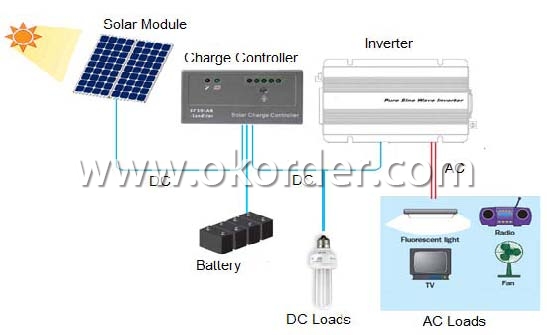
Components of Solar Energy System CNBM-K5 (500W)
PV Array:
Convert sunlight instantly into DC electric power. Formed by the solar modules (also called photovoltaic modules) in accordance with the system requirements for series and parallel.
Solar Charge Controller:
A charge controller may be used to power DC equipment with solar panels. The charge controller provides a regulated DC output and stores excess energy in a battery as well as monitoring the battery voltage to prevent over charge or over discharge. An inverter can be connected to the output of a charge controller to drive AC loads.
Inverter:
Converts DC output power of photovaltaic soalr panels into standard AC power for use in the local off-grid electrical network. It is a critical component in a photovoltaic system, allowing the use of ordinary commercial appliances.
Battery banks:
Stores energy when there is an excess coming in and distribute it back out when there is a demand. Solar PV panels continue to re-charge batteries each day to maintain battery charge.
Technical data of Solar Home System CNBM-K5 (500W) | ||
Inverter | Rated load power | 1000W |
Output wave | Pure sine wave | |
Output voltage | DC 24V | |
Output frequency |
AC:220V | |
Precision of output | 50HZ/60HZ | |
Precision of output frequency | ±6% | |
Solar panel | Pmax | 165W*3PCS |
Vmp | 36V | |
Imp | 4.63A*3 | |
Charger | Charger voltage & current | 24V /10A*3 |
Battery | Capacity | 12V 120AH*2PCS |
Power box | Spray paint iron box,with input,output,ammeter,voltmeter,master swith and so on. | |
Package of Solar Home System CNBM-K5 (500W) | ||||
Part | Size(L*W*H mm) | Weight(kg) | 20’(pcs) | 40’(pcs) |
Power box | 580*520*540 | 60 | 70 Sets | 160 Sets |
Solar panel | 1600*830*90 | 45 | ||
Battery | 420*360*240 | 80 | ||
Factory Picture of Solar Energy System CNBM-K5 (500W)
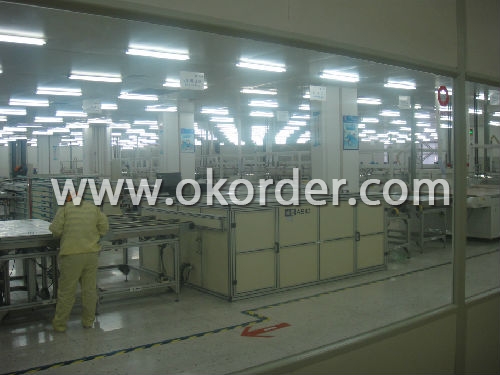
Package Picture of Solar Energy System CNBM-K5 (500W)
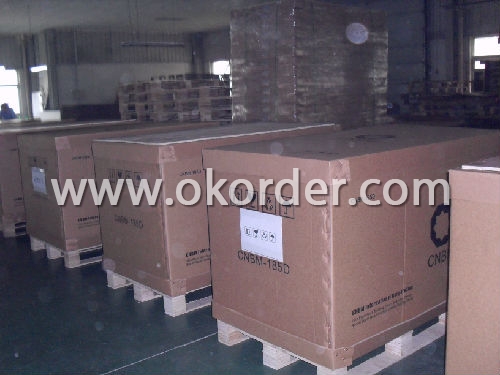
- Q: How does solar energy compare to other renewable energy sources like wind or hydro power?
- Solar energy, like wind and hydro power, is a crucial renewable energy source. However, it has its own unique advantages and disadvantages when compared to other renewables. Solar energy is abundant, easily accessible, and can be harnessed almost anywhere. While wind power may have the potential to generate more electricity, solar energy is more consistent and reliable. Similarly, hydro power is more efficient in terms of energy production, but it is limited by geographical constraints. Ultimately, the choice between these renewable sources depends on specific circumstances, such as location, available resources, and energy demands.
- Q: Are there any fire risks associated with solar energy systems?
- Yes, there are fire risks associated with solar energy systems, although they are relatively low compared to other energy sources. The most common fire risks include electrical malfunctions, such as faulty wiring or connectors, and overheating of components. However, modern solar systems are designed with safety measures, such as built-in fire barriers and automatic shut-off mechanisms, to minimize these risks. Regular maintenance and inspections by qualified professionals can further reduce the chances of fire incidents.
- Q: How does the installation process of a solar energy system work?
- The installation process of a solar energy system typically involves several steps. First, a site assessment is conducted to determine the feasibility of installing solar panels and assess the energy needs of the property. Then, the necessary permits and paperwork are obtained. Next, the solar panels and associated equipment are installed on the roof or ground, ensuring proper placement and orientation for maximum sunlight exposure. Electrical wiring and connections are made to integrate the system with the existing electrical system of the property. Finally, the system is tested and commissioned to ensure it is functioning correctly, and the owner is provided with guidance on maintenance and monitoring.
- Q: Are solar energy systems suitable for agricultural applications?
- Yes, solar energy systems are suitable for agricultural applications. They provide a sustainable and reliable source of power for various agricultural operations such as irrigation, livestock management, and powering machinery. Solar energy systems can help reduce dependence on fossil fuels, lower operating costs, and contribute to a more environmentally friendly farming practice.
- Q: Can solar energy systems be used in areas with extreme temperature fluctuations?
- Yes, solar energy systems can be used in areas with extreme temperature fluctuations. While extreme temperatures can affect the efficiency of solar panels to some extent, modern solar technology is designed to withstand a wide range of temperatures. Additionally, proper installation and maintenance can help mitigate any potential issues caused by temperature fluctuations.
- Q: Can solar energy systems be used for powering amusement parks?
- Yes, solar energy systems can definitely be used to power amusement parks. By installing solar panels, amusement parks can generate clean and renewable energy to meet their power needs. Solar energy systems can provide electricity for rides, lighting, and other facilities within the park, reducing the reliance on fossil fuels and lowering operational costs. Additionally, solar power can contribute to a greener image for the amusement park, attracting environmentally conscious visitors.
- Q: Can solar energy systems be used in powering retirement homes or assisted living facilities?
- Yes, solar energy systems can definitely be used to power retirement homes or assisted living facilities. Solar panels can be installed on the roofs or in open spaces of these facilities to capture sunlight and convert it into electricity. This renewable energy can then be used to power various amenities such as lighting, heating, cooling, and appliances, reducing their reliance on traditional power sources and lowering energy costs. Additionally, solar energy systems are environmentally friendly and sustainable, aligning with the growing trend of integrating green solutions in retirement homes and assisted living facilities.
- Q: Can solar energy systems be used for powering factories?
- Yes, solar energy systems can certainly be used for powering factories. Solar panels can be installed on the rooftops or open spaces around factories to capture sunlight and convert it into electricity. This renewable energy source can provide a significant portion or even the entire energy needs of a factory, reducing reliance on non-renewable sources and lowering carbon emissions.
- Q: Can a solar energy system be installed on a building with a flat roof?
- Yes, a solar energy system can be installed on a building with a flat roof. In fact, flat roofs are often preferred for solar panel installations due to their ease of access and optimal sunlight exposure. Solar panels can be mounted directly on the flat surface of the roof using ballast, which is a weight-based system that does not require any roof penetrations. Additionally, flat roofs provide ample space for arranging the solar panels in an optimal manner, maximizing the energy production. Therefore, flat roofs are an excellent option for installing solar energy systems and can contribute significantly to generating clean and sustainable electricity.
- Q: Can solar energy systems be used in powering airports or transportation hubs?
- Yes, solar energy systems can be used to power airports and transportation hubs. Solar power is a renewable and sustainable energy source that can be harnessed through the installation of solar panels. These solar panels can be placed on the roofs of airport buildings, parking lots, or even on the ground surrounding the airport. Solar energy can be used to power various aspects of airports and transportation hubs. For example, solar panels can generate electricity to power lighting systems, security cameras, and other electrical equipment within the airport premises. Solar power can also be used to charge electric vehicles, such as electric buses or airport shuttles, which can help reduce carbon emissions and promote a cleaner transportation system. Furthermore, solar energy systems can provide a reliable backup power source during emergencies or power outages. This is especially crucial for airports, as they need to ensure continuous operations and maintain safety measures at all times. In recent years, several airports around the world have embraced solar energy as a way to reduce their carbon footprint and operating costs. For instance, Cochin International Airport in India became the world's first fully solar-powered airport in 2015. This airport generates more than enough electricity to meet its operational needs and even feeds excess power back into the grid. Overall, incorporating solar energy systems into airports and transportation hubs is not only environmentally friendly but also economically beneficial in the long run. It helps reduce reliance on fossil fuels, lowers energy costs, and contributes to a more sustainable and greener transportation infrastructure.
Send your message to us
Commercial Solar Energy Systems - CNBM Solar Home System CNBM-K5 (500W)
- Loading Port:
- China Main Port
- Payment Terms:
- TT
- Min Order Qty:
- 1 set set
- Supply Capability:
- 1000 sets per month set/month
OKorder Service Pledge
OKorder Financial Service
Similar products
Hot products
Hot Searches
Related keywords



